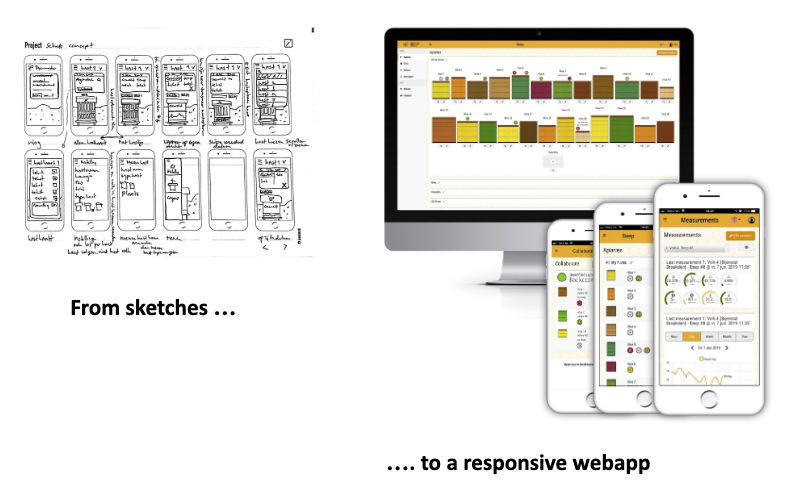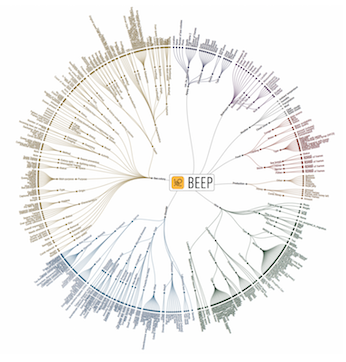History
by Marten Schoonman, co-founder and co-director
November 2019
In 2016 I posted a blog about digitale beehive monitoring, in which I described the opportunities it could have. I have not let go of that quest since. It lead to the formation of the BEEP foundation.
A brief history
Developing digital tools for bees was not a one man job. I met with Pim van Gennip, a designer and developer, who got interested in the concept. He helped me out with the construction of the first version of what we now call the BEEP base. We brainstormed with beekeepers in Amsterdam at Beelease and Utrecht at BVU. Based on these sessions we decided that our first step in helping beekeepers would be to modernise beekeeping administration with digital colony hive logs, instead of the paper version that is widely used.
Beelease did great in conducting a small scale crowdfunding campaign to fund the first version of the BEEP app, a responsive website or webapp. We focussed on creating a so-called minimal viable product to check its feasibility among beekeepers. It was the first step on our BEEP journey and serious numbers of beekeepers signed up. In this stage, Bente Deenekamp contributed her talent and designed our logo. As we moved on, we discovered BEEP's way of working, which we like to describe as forward looking, iterative and solution-minded.

2017
The year in which Pim and I registered the BEEP Foundation. Why a mission driven and not a for-profit organization? There is a lot to discover and develop regarding honeybee health monitoring. We do not want to and cannot do that all by ourselves. We believe that an open source approach fosters collaboration and knowledge exchange. I did not base that on loose thoughts, but on the experience I gained working for the social enterprise Akvo Foundation. Looking back, we're very pleased with the network, progress and funding opportunities this approach brought our initiative.
Science
Bees, honeybees and wild bees, are a popular researched subject. It makes sense; our food and even our lives depend on their pollination service. Beekeepers are still figuring out how to best manage the health of honeybees. However, beekeepers are also considered to be a major threat for honeybees. This means beekeeping practices need to improve! We aim to support those necessary improvements with our work at BEEP. For us, it made sense to link the tech work to science. We invited prof. dr. Koos Biesmeijer to our initiative, and he enthusiastically accepted.
Data structure

To bridge the gap between the practice of beekeeping and bee research we decided to build a data structure. This hierarchical tree structure with data categories standardises and classifies the terminology of both practice and science and the logical relationships among the terms. Researchers and beekeepers can select their preferred terminology based on their needs throughout the beekeeping season. The data structure was implemented with support from the SIDN fund, among others, in version 2 of the BEEP webapp in 2018. The construction of the data structure was a puzzle that took several months of consulting heaps of sources. It is now one of the inputs for an international group of likeminded bee researchers called BeeXML with a working group under the umbrella of Apimondia, the international federation of beekeepers' associations.
Click here to have a look at the current version of the BEEP data structure.
Sensors
My search for the possibilities of using sensors in my work with bee colonies bring me back to 2016. What I found ranged from NASA investigating colony losses with sensors, commercial products (which I considered expensive) and do-it-yourself (DIY) projects. I did not find a solution which fitted me and settled for trying the DIY approach. I got stuck on getting the electronics to work. This lead to meeting Pim and his company Iconize. Toghether we made version 1 of the BEEP measurement system. It is a makeshift wooden scale with a Sodaq Arduino autonomo with GSM connection. It was a good start but not quite the user-friendly, robust, affordable and flexible product we aimed to develop. Over 2017 and 2018 we met with others working in this area, did research ourselves and in collaboration with schools and universities, sourced funding, built and tested. Stephan Peterse did great work on building hives (version 2 was a lot of work including soldering) and bringing the technical designs to the next level with lots of positive criticism. Find out more about the technical specification of the BEEP base version 3 and version 2.

BEEP base
Version 3, which we call the BEEP base, is now ready to be used. Great design work is done by Nout van Heumen in balancing look-and-feel, robustness and costs. Interested in our Kickstarter campaign? Click here!
Moving ahead
The initiators of the citizen science project, Bee Observer Bremen, asked if they could use the BEEP app. They wanted to connect to the Hiveeyes open source sensor systems, one of our partners, in a project with 200 beekeepers. This was the first collaboration with scientists. At the end of 2017 we were asked by Bees@WUR to join a consortium. The consortium was formed to respond to a call for funding to help making beekeeping healthy and sustainable. Our proposal was accepted and the B-Good project started in June 2019. The project is lead by prof. dr. Dirk de Graaf of the Ghent University. BEEP has contracted a team of experts and works with a community of over 100 beekeepers and technicians to build upon and extend the foundation of the BEEP app and BEEP base. Both will be tested, evaluated and further enhanced in three large iterations. Our sub-goals are to develop a bee health data portal and contribute to make the Healthy-B toolbox practical to use. The EU funded project will run until end of 2023.
We are excited to support the worldwide quest of taking care of managed honeybees in the best way possible. We develop, in collaboration with other organisations and volunteers, tools that enable the bees to tell us when they need our help. So we can let them bee the rest of the time. Read more about the composition of the BEEP team here.
